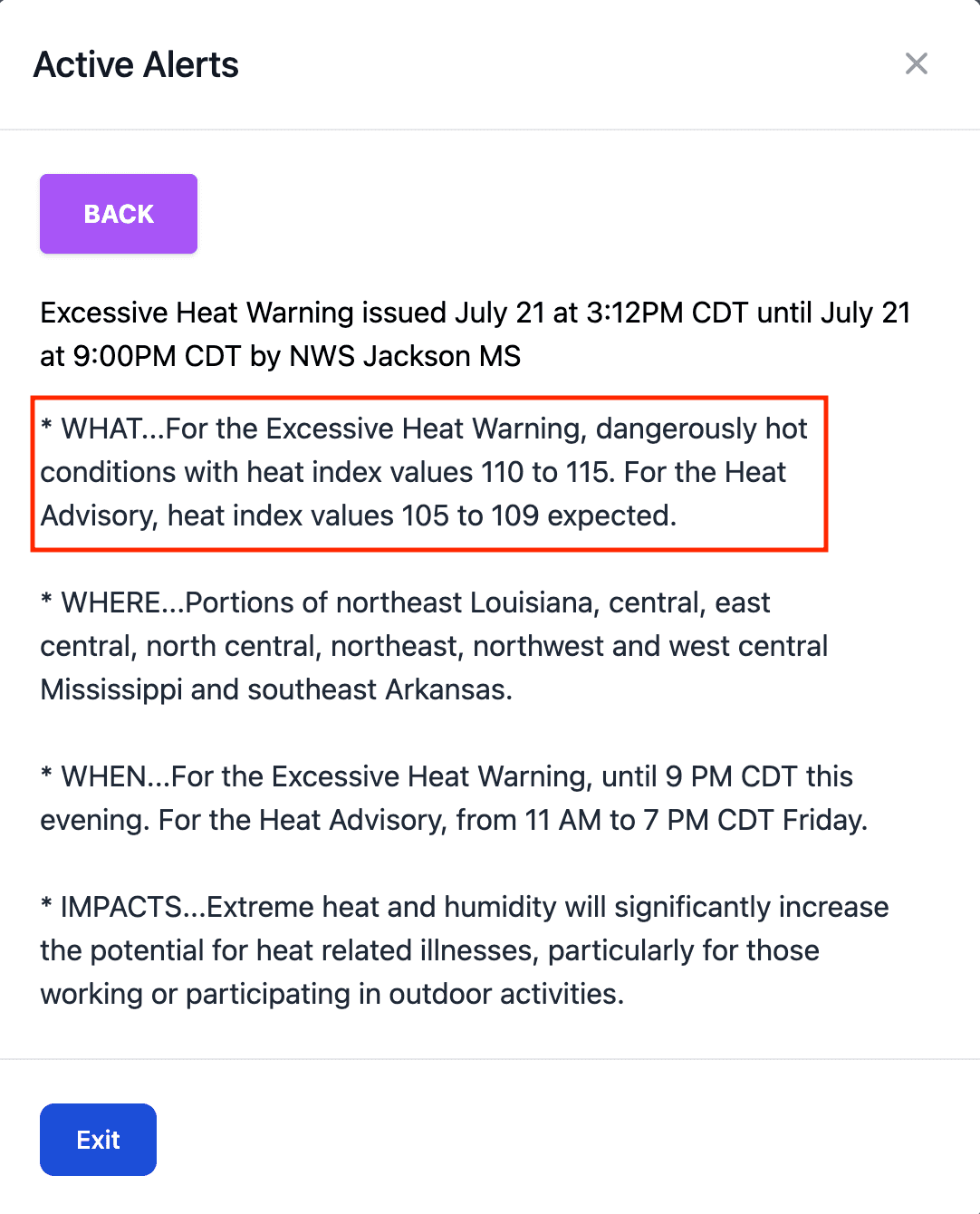Understanding The Absence Of Excessive Heat Warnings In Weather Reports

Table of Contents
Factors Influencing the Issuance of Excessive Heat Warnings
Several factors influence whether or not an Excessive Heat Warning is issued. These range from the specific criteria used to define dangerous heat to the limitations of weather forecasting and data availability.
Thresholds and Criteria
Meteorological agencies use specific temperature and humidity thresholds to determine when to issue Excessive Heat Warnings. These thresholds are often expressed as the heat index or apparent temperature, which combine air temperature and relative humidity to represent the perceived temperature. These metrics attempt to quantify the body’s ability to cool itself through sweating.
- Heat Index: This is a widely used metric, combining temperature and humidity to indicate the perceived air temperature.
- Apparent Temperature: Similar to the heat index, this accounts for wind chill and other factors that affect how hot it feels.
- Variations in Thresholds: The exact thresholds for issuing an Excessive Heat Warning can vary between countries and even regions within a country, reflecting different climatic norms and population vulnerabilities. These variations can sometimes lead to inconsistencies in warning issuance across geographical areas experiencing similar heat levels. This variation often stems from the different historical data used to calibrate warning systems locally.
The thresholds themselves might not always capture extreme local conditions. Urban heat islands, for example, experience significantly higher temperatures than surrounding rural areas, and these localized variations may not be fully reflected in the broader warning criteria.
Data Availability and Reliability
Accurate heat warnings rely heavily on reliable weather data. This data comes from various sources:
- Weather Stations: These provide ground-level temperature, humidity, and other crucial meteorological data. However, their distribution is often uneven, with sparse coverage in rural areas or developing countries.
- Satellite Data: Satellites offer broader coverage, providing temperature data over larger regions. However, their accuracy can be limited, particularly at a local level.
- Forecasting Models: Sophisticated computer models process weather data to predict future conditions. These models are continuously improving, but they still have limitations in accurately predicting the precise intensity and location of extreme heat events.
Challenges in data collection and processing can hinder the timely issuance of Excessive Heat Warnings. This includes:
- Sparse Weather Station Networks: Limited weather station coverage, particularly in remote areas, can lead to insufficient data for accurately assessing heat risk.
- Technological Limitations: Outdated equipment or a lack of access to advanced technologies can also affect data quality and availability.
- Data Processing Delays: Delays in processing and analyzing vast amounts of weather data can cause delays in warning dissemination.
Forecasting Limitations
Accurately predicting extreme heat events several days in advance is inherently challenging. Weather patterns are dynamic and complex, influenced by numerous interacting factors.
- Complex Weather Modeling: Weather models, while sophisticated, still struggle with the complexities of heat waves, particularly in predicting their intensity and duration with complete accuracy.
- Unforeseen Factors: Unforeseeable events like unexpected changes in wind patterns or the sudden influx of hot air masses can significantly impact heat wave intensity, making accurate long-range forecasting difficult.
Communication and Dissemination of Excessive Heat Warnings
Even with accurate forecasts, effective communication is crucial for ensuring that Excessive Heat Warnings reach the public and elicit appropriate responses.
Warning Systems and Reach
Various channels are used to communicate Excessive Heat Warnings:
- Weather Apps: Mobile weather applications provide real-time alerts and forecasts directly to users.
- Television and Radio: Traditional broadcast media remain important channels, especially for reaching older populations or those with limited internet access.
- Social Media: Social media platforms increasingly play a role in disseminating warnings, although their reach can be uneven, and the information they carry might not always be reliable.
However, challenges remain in ensuring these systems reach everyone:
- Digital Divide: Unequal access to technology and the internet leaves many individuals vulnerable to being missed by digital warning systems.
- Language Barriers: Warnings must be clear and accessible in multiple languages to reach diverse populations.
- Lack of Awareness: Many people are not fully aware of the various warning systems in place or the significance of heat warnings.
Public Perception and Response
The effectiveness of Excessive Heat Warnings depends also on public awareness and response:
- Complacency: People may become complacent towards repeated warnings, especially if extreme heat is a regular occurrence.
- Heat Acclimatization: Individuals who gradually acclimate to higher temperatures might underestimate their own heat vulnerability.
- Socioeconomic Factors: Socioeconomic factors can significantly influence an individual's ability to respond to heat warnings, with those in lower socioeconomic groups often facing greater risk due to limited access to cooling resources.
Other Contributing Factors to the Absence of Warnings
Beyond the factors already discussed, other constraints can affect the issuance of Excessive Heat Warnings.
Resource Constraints
Smaller meteorological agencies often face limitations in resources:
- Staffing Shortages: Limited personnel may hinder the timely processing of weather data and the issuance of warnings.
- Funding Constraints: Inadequate funding can limit the ability to maintain and upgrade equipment and technology.
Prioritization of Other Weather Events
In situations with multiple severe weather threats, prioritization is necessary:
- Competing Events: When hurricanes, tornadoes, or other severe weather events occur concurrently, they might overshadow heat warnings in the public eye and even in the allocation of resources within meteorological agencies.
Conclusion
The absence of Excessive Heat Warnings in weather reports can stem from a confluence of factors, including the complexity of accurately forecasting extreme heat, challenges in data availability and reliability, limitations in warning dissemination, and public perception issues. Reliable data, accurate forecasting models, effective communication strategies, and sufficient resources are vital for ensuring timely and effective Excessive Heat Warnings. The dangers of heat waves are substantial, and these warnings play a critical role in protecting public health. Stay informed about weather forecasts through reliable sources, understand the meaning and significance of Excessive Heat Warnings, and take necessary precautions during periods of extreme heat. Improved systems and increased public awareness are crucial for mitigating the risks of heat-related illnesses. Take personal responsibility for your safety by staying informed about impending Excessive Heat Warnings and by taking proactive steps to stay cool and safe during heat waves.

Featured Posts
-
 Hvem Skal Erstatte Dolberg Tipsbladets Analyse
May 30, 2025
Hvem Skal Erstatte Dolberg Tipsbladets Analyse
May 30, 2025 -
 Boesen To Deliver Grand View University Commencement Address
May 30, 2025
Boesen To Deliver Grand View University Commencement Address
May 30, 2025 -
 Kan Anderlecht Sige Nej Til Et Godt Tilbud
May 30, 2025
Kan Anderlecht Sige Nej Til Et Godt Tilbud
May 30, 2025 -
 Cambios En La Politica De Precios De Ticketmaster Entendiendo Los Costos De Las Entradas
May 30, 2025
Cambios En La Politica De Precios De Ticketmaster Entendiendo Los Costos De Las Entradas
May 30, 2025 -
 Gorillazs 25th Anniversary House Of Kong Exhibition And Exclusive London Gigs
May 30, 2025
Gorillazs 25th Anniversary House Of Kong Exhibition And Exclusive London Gigs
May 30, 2025
